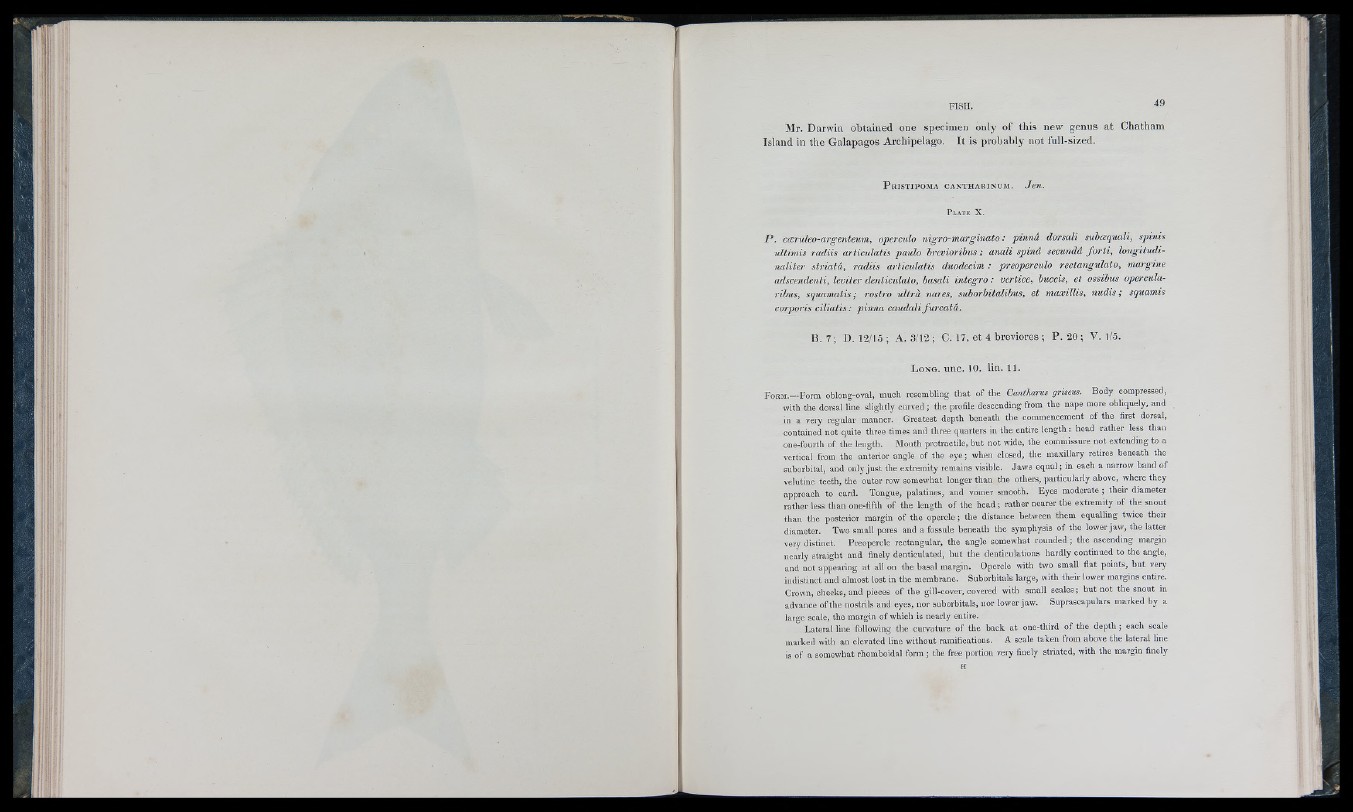
Mr. Darwin obtained one specimen only of this new genus at Chatham
Island in the Galapagos Archipelago. It is probably not full-sized.
P r is t ip o m a c a n t h a r in u m . Jen.
P . cceruleo-argenteum, operculo nigro-marginato : pinnà dorsali subaquali, spinis
xiltimis radiis articulatis paxdo brevioidhxis ; anali spina secunda forti, longitudi-
naliter striata, radiis articulatis dxiodecim : preoperculo rectangxilato, margixie
adscendenti, leviter denticulato, basali integro : vertice, huccis, et ossibus opercula-
ribus, squamatis; rostro ulti'à nares, suboi'bitalibus, et maxillis, iiudis ; squamis
corporis ciliatis: pinna caudalifarcatà.
B. 7 ; D. 12/15 ; A. 3/12 ; C. 17, et 4 breviores ; P. 20 ; V. 1/5.
L o n g . u n c . 10. lin . 11.
F o r m .— Form oblong-oval, much resembling th a t of the Cantharus griseus. Body compressed,
with the doi-sal line slightly curved ; the profile descending from the nape more obliquely, and
in a very regular manner. Greatest depth beneath the commencement of the first dorsal,
contained not quite three times and three quarters in the entire len g th : head rather less than
one-fourth of the length. Mouth protractile, but not wide, the commissure not extending to a
vertical from the anterior angle of the eye; when closed, the maxillary retires beneath the
suborbital, and o nlyjust the extremity remains visible. Jaw s equal; m each a narrow band of
velutine teeth, the outer row somewhat longer than the others, particularly above, where they
approach to card. Tongue, palatines, and vomer smooth. Eyes m oderate; their diameter
rather less than one-fifth of the length of the h e a d ; rather nearer the extremity o f the snout
than the posterior margin of the opercle; the distance between them equalling twice their
diameter. Two small pores and a fossule beneath the symphysis of the lower jaw , the latter
very distinct. Preopercle rectangular, the angle somewhat rounded; the ascending margin
nearly straight and finely denticulated, but the denticulations hardly continued to the angle,
and not appearing at all on the basal margin. Opercle with two small fiat points, but very
indistinct and almost lost in the membrane. Suborbitals large, with their lower margins entire.
Crown, cheeks, and pieces of the gill-cover, covered with small scales; but not the snout in
advance of the nostrils and eyes, nor suborbitals, nor lower jaw . Suprascapulars marked by a
largo scale, the margin of which is nearly entire.
Lateral line following tlie curvature of the back at one-third of the d e p th ; each scale
marked with an elevated line without ramifications. A scale taken from above the lateral line
is of a somewhat rhomboidal form ; the free portion very finely striated, with the margin finely